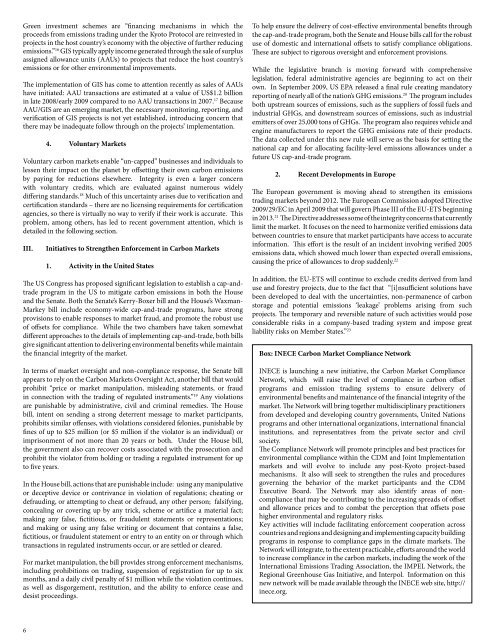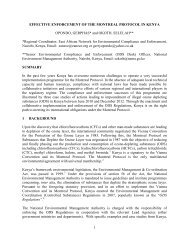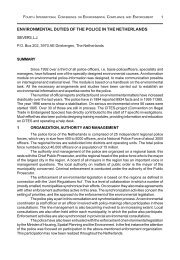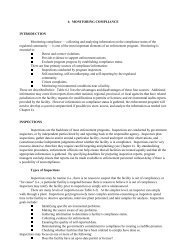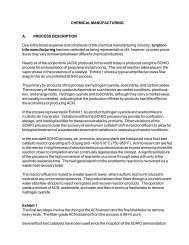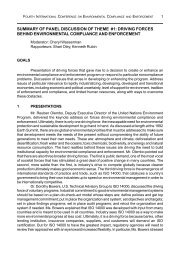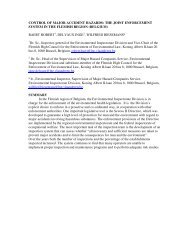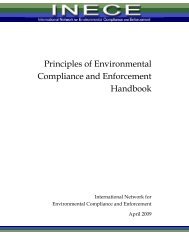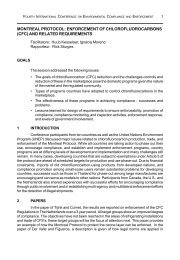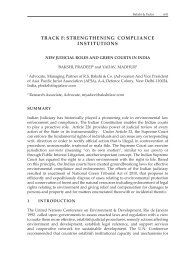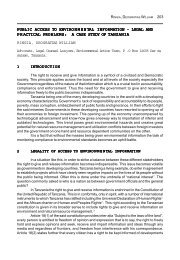Special Report on Climate Compliance - Inece
Special Report on Climate Compliance - Inece
Special Report on Climate Compliance - Inece
- No tags were found...
Create successful ePaper yourself
Turn your PDF publications into a flip-book with our unique Google optimized e-Paper software.
Green investment schemes are “financing mechanisms in which theproceeds from emissi<strong>on</strong>s trading under the Kyoto Protocol are reinvested inprojects in the host country’s ec<strong>on</strong>omy with the objective of further reducingemissi<strong>on</strong>s.” 16 GIS typically apply income generated through the sale of surplusassigned allowance units (AAUs) to projects that reduce the host country’semissi<strong>on</strong>s or for other envir<strong>on</strong>mental improvements.The implementati<strong>on</strong> of GIS has come to attenti<strong>on</strong> recently as sales of AAUshave initiated: AAU transacti<strong>on</strong>s are estimated at a value of US$1.2 billi<strong>on</strong>in late 2008/early 2009 compared to no AAU transacti<strong>on</strong>s in 2007. 17 BecauseAAU/GIS are an emerging market, the necessary m<strong>on</strong>itoring, reporting, andverificati<strong>on</strong> of GIS projects is not yet established, introducing c<strong>on</strong>cern thatthere may be inadequate follow through <strong>on</strong> the projects’ implementati<strong>on</strong>.4. Voluntary MarketsVoluntary carb<strong>on</strong> markets enable “un-capped” businesses and individuals tolessen their impact <strong>on</strong> the planet by offsetting their own carb<strong>on</strong> emissi<strong>on</strong>sby paying for reducti<strong>on</strong>s elsewhere. Integrity is even a larger c<strong>on</strong>cernwith voluntary credits, which are evaluated against numerous widelydiffering standards. 18 Much of this uncertainty arises due to verificati<strong>on</strong> andcertificati<strong>on</strong> standards – there are no licensing requirements for certificati<strong>on</strong>agencies, so there is virtually no way to verify if their work is accurate. Thisproblem, am<strong>on</strong>g others, has led to recent government attenti<strong>on</strong>, which isdetailed in the following secti<strong>on</strong>.III.Initiatives to Strengthen Enforcement in Carb<strong>on</strong> Markets1. Activity in the United StatesThe US C<strong>on</strong>gress has proposed significant legislati<strong>on</strong> to establish a cap-andtradeprogram in the US to mitigate carb<strong>on</strong> emissi<strong>on</strong>s in both the Houseand the Senate. Both the Senate’s Kerry-Boxer bill and the House’s Waxman-Markey bill include ec<strong>on</strong>omy-wide cap-and-trade programs, have str<strong>on</strong>gprovisi<strong>on</strong>s to enable resp<strong>on</strong>ses to market fraud, and promote the robust useof offsets for compliance. While the two chambers have taken somewhatdifferent approaches to the details of implementing cap-and-trade, both billsgive significant attenti<strong>on</strong> to delivering envir<strong>on</strong>mental benefits while maintainthe financial integrity of the market.In terms of market oversight and n<strong>on</strong>-compliance resp<strong>on</strong>se, the Senate billappears to rely <strong>on</strong> the Carb<strong>on</strong> Markets Oversight Act, another bill that wouldprohibit “price or market manipulati<strong>on</strong>, misleading statements, or fraudin c<strong>on</strong>necti<strong>on</strong> with the trading of regulated instruments.” 19 Any violati<strong>on</strong>sare punishable by administrative, civil and criminal remedies. The Housebill, intent <strong>on</strong> sending a str<strong>on</strong>g deterrent message to market participants,prohibits similar offenses, with violati<strong>on</strong>s c<strong>on</strong>sidered fel<strong>on</strong>ies, punishable byfines of up to $25 milli<strong>on</strong> (or $5 milli<strong>on</strong> if the violator is an individual) orimpris<strong>on</strong>ment of not more than 20 years or both. Under the House bill,the government also can recover costs associated with the prosecuti<strong>on</strong> andprohibit the violator from holding or trading a regulated instrument for upto five years.In the House bill, acti<strong>on</strong>s that are punishable include: using any manipulativeor deceptive device or c<strong>on</strong>trivance in violati<strong>on</strong> of regulati<strong>on</strong>s; cheating ordefrauding, or attempting to cheat or defraud, any other pers<strong>on</strong>; falsifying,c<strong>on</strong>cealing or covering up by any trick, scheme or artifice a material fact;making any false, fictitious, or fraudulent statements or representati<strong>on</strong>s;and making or using any false writing or document that c<strong>on</strong>tains a false,fictitious, or fraudulent statement or entry to an entity <strong>on</strong> or through whichtransacti<strong>on</strong>s in regulated instruments occur, or are settled or cleared.For market manipulati<strong>on</strong>, the bill provides str<strong>on</strong>g enforcement mechanisms,including prohibiti<strong>on</strong>s <strong>on</strong> trading, suspensi<strong>on</strong> of registrati<strong>on</strong> for up to sixm<strong>on</strong>ths, and a daily civil penalty of $1 milli<strong>on</strong> while the violati<strong>on</strong> c<strong>on</strong>tinues,as well as disgorgement, restituti<strong>on</strong>, and the ability to enforce cease anddesist proceedings.To help ensure the delivery of cost-effective envir<strong>on</strong>mental benefits throughthe cap-and-trade program, both the Senate and House bills call for the robustuse of domestic and internati<strong>on</strong>al offsets to satisfy compliance obligati<strong>on</strong>s.These are subject to rigorous oversight and enforcement provisi<strong>on</strong>s.While the legislative branch is moving forward with comprehensivelegislati<strong>on</strong>, federal administrative agencies are beginning to act <strong>on</strong> theirown. In September 2009, US EPA released a final rule creating mandatoryreporting of nearly all of the nati<strong>on</strong>’s GHG emissi<strong>on</strong>s. 20 The program includesboth upstream sources of emissi<strong>on</strong>s, such as the suppliers of fossil fuels andindustrial GHGs, and downstream sources of emissi<strong>on</strong>s, such as industrialemitters of over 25,000 t<strong>on</strong>s of GHGs. The program also requires vehicle andengine manufacturers to report the GHG emissi<strong>on</strong>s rate of their products.The data collected under this new rule will serve as the basis for setting thenati<strong>on</strong>al cap and for allocating facility-level emissi<strong>on</strong>s allowances under afuture US cap-and-trade program.2. Recent Developments in EuropeThe European government is moving ahead to strengthen its emissi<strong>on</strong>strading markets bey<strong>on</strong>d 2012. The European Commissi<strong>on</strong> adopted Directive2009/29/EC in April 2009 that will govern Phase III of the EU-ETS beginningin 2013. 21 The Directive addresses some of the integrity c<strong>on</strong>cerns that currentlylimit the market. It focuses <strong>on</strong> the need to harm<strong>on</strong>ize verified emissi<strong>on</strong>s databetween countries to ensure that market participants have access to accurateinformati<strong>on</strong>. This effort is the result of an incident involving verified 2005emissi<strong>on</strong>s data, which showed much lower than expected overall emissi<strong>on</strong>s,causing the price of allowances to drop suddenly. 22In additi<strong>on</strong>, the EU-ETS will c<strong>on</strong>tinue to exclude credits derived from landuse and forestry projects, due to the fact that “[i]nsufficient soluti<strong>on</strong>s havebeen developed to deal with the uncertainties, n<strong>on</strong>-permanence of carb<strong>on</strong>storage and potential emissi<strong>on</strong>s ‘leakage’ problems arising from suchprojects. The temporary and reversible nature of such activities would posec<strong>on</strong>siderable risks in a company-based trading system and impose greatliability risks <strong>on</strong> Member States.” 23Box: INECE Carb<strong>on</strong> Market <strong>Compliance</strong> NetworkINECE is launching a new initiative, the Carb<strong>on</strong> Market <strong>Compliance</strong>Network, which will raise the level of compliance in carb<strong>on</strong> offsetprograms and emissi<strong>on</strong> trading systems to ensure delivery ofenvir<strong>on</strong>mental benefits and maintenance of the financial integrity of themarket. The Network will bring together multidisciplinary practiti<strong>on</strong>ersfrom developed and developing country governments, United Nati<strong>on</strong>sprograms and other internati<strong>on</strong>al organizati<strong>on</strong>s, internati<strong>on</strong>al financialinstituti<strong>on</strong>s, and representatives from the private sector and civilsociety.The <strong>Compliance</strong> Network will promote principles and best practices forenvir<strong>on</strong>mental compliance within the CDM and Joint Implementati<strong>on</strong>markets and will evolve to include any post-Kyoto project-basedmechanisms. It also will seek to strengthen the rules and proceduresgoverning the behavior of the market participants and the CDMExecutive Board. The Network may also identify areas of n<strong>on</strong>compliancethat may be c<strong>on</strong>tributing to the increasing spreads of offsetand allowance prices and to combat the percepti<strong>on</strong> that offsets posehigher envir<strong>on</strong>mental and regulatory risks.Key activities will include facilitating enforcement cooperati<strong>on</strong> acrosscountries and regi<strong>on</strong>s and designing and implementing capacity buildingprograms in resp<strong>on</strong>se to compliance gaps in the climate markets. TheNetwork will integrate, to the extent practicable, efforts around the worldto increase compliance in the carb<strong>on</strong> markets, including the work of theInternati<strong>on</strong>al Emissi<strong>on</strong>s Trading Associati<strong>on</strong>, the IMPEL Network, theRegi<strong>on</strong>al Greenhouse Gas Initiative, and Interpol. Informati<strong>on</strong> <strong>on</strong> thisnew network will be made available through the INECE web site, http://inece.org.6


